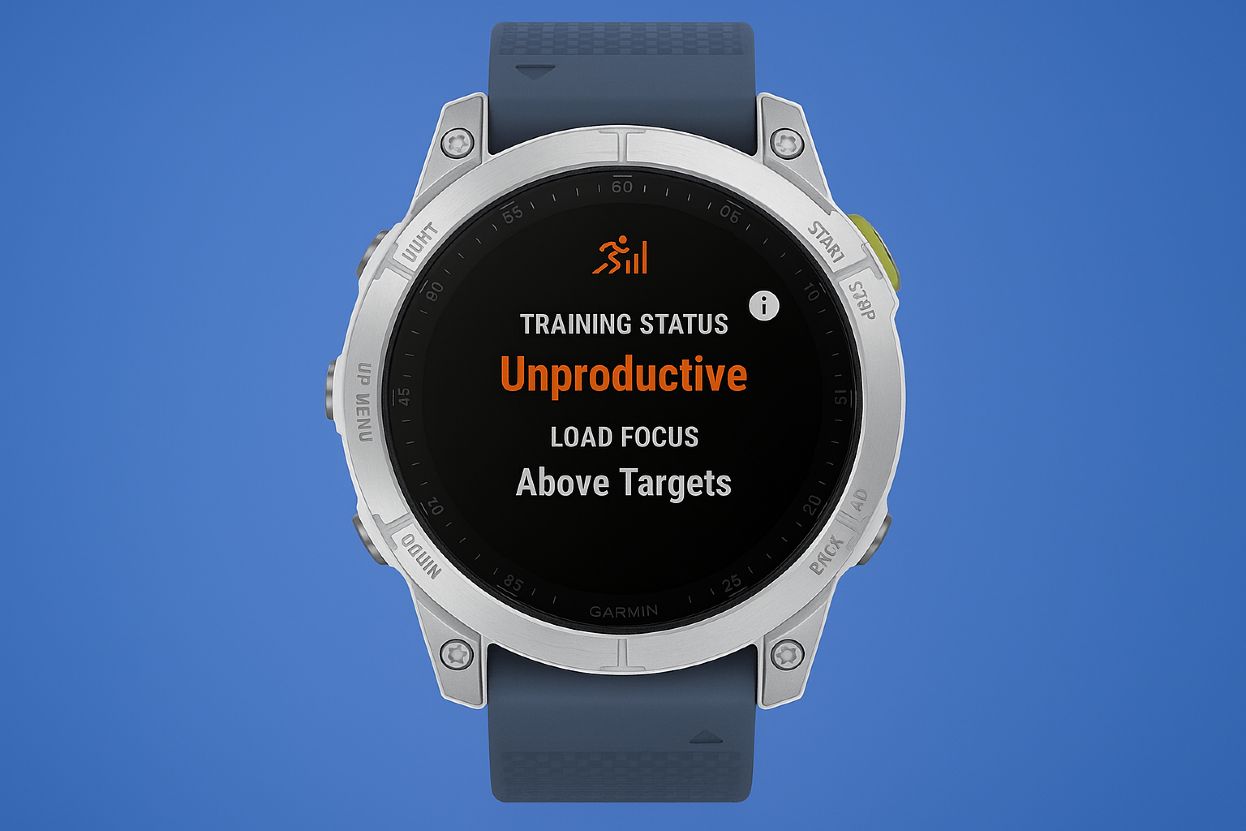Understanding the fitness stats on your GPS watch: Garmin, Coros, Suunto & Polar
Mark Green

Have you ever had your Garmin tell you that you’re “Unproductive” — even when you’re training more than ever?
It’s not broken, and you’re not doing anything wrong. In fact, if you’re in our base training phase, or you are focussing mainly on Zone 2 training, then you’re most likely getting fitter but your watch doesn’t understand it …
How Garmin Decides Your Training Status
Garmin’s “Training Status” comes from an algorithm (made by Firstbeat) that looks at your VO₂ max trend, training load, and the mix of workout intensities you’re doing.
To get a “Productive” rating, Garmin wants to see:
- Your VO₂ max going up
- A mix of easy, moderate, and high-intensity training
- If your VO₂ max stays the same or dips slightly, and almost all of your runs are easy, Garmin thinks you’re stagnating.
VO₂ max is basically your engine size
VO₂ max is a measure of how much oxygen your body can use when you’re working as hard as you possibly can. Oxygen is the fuel your muscles need to keep going, so the more you can take in and use, the more power and endurance you have.
If two runners are working at the same effort, the one with the higher VO₂ max is usually able to go faster or last longer before fatigue sets in — just like a bigger engine can go faster without red-lining.
That’s why Garmin and other watches get excited when VO₂ max goes up — they see it as a sign your “engine” has more capacity. But in base training, we’re quietly upgrading the wiring, the fuel efficiency, and the reliability of that engine, which VO₂ max doesn’t immediately notice.
Why Zone 2 Training Confuses Your Watch
Zone 2 base training is deliberately low intensity. The whole idea is to build your aerobic fitness, improve fat-burning efficiency, and strengthen your body for harder training later on.
Garmin estimates VO₂ max mostly from pace and heart rate at higher intensities. If you never do those harder sessions, your VO₂ max number won’t move much in the short term — so Garmin assumes you’re not improving.
In reality, you’re building the foundation that will let you smash PBs when you add intensity later.
Think of It Like This…
You know the story about the Tortoise and the Hare. Imagine they’re running a half marathon around a 400m track. Garmin is like a race commentator who gets super excited every time the hare sprints past the start/finish line. If you’re in base training, then you’re the tortoise — quietly and consistently clocking up lap after lap, even though the commentator barely notices you. What the commentator (Garmin) fails to see is that after all this time, you’ve done 50 laps while the hare has only managed 43, because he keeps overcooking himself with bursts of sprinting.
What statistics you should actually care about
During base training, ignore “Training Status” and pay more attention to other Garmin stats that actually reflect your progress:
- Resting Heart Rate: Is it trending down over weeks? That’s a good sign.
- HRV (Heart Rate Variability): Stable or improving numbers mean your body is adapting.
- Body Battery & Stress Score: Good recovery scores = you’re balancing training and rest.
- Aerobic Training Effect: Anything above 1.5 means you’re stimulating aerobic fitness.
Coros Fitness Stats
Coros offers similar training feedback, but its Training Status is based on your Base Fitness (long-term aerobic capacity) versus your Load Impact (fatigue from recent workouts).
- If your load is high but your base is low, it will warn you you’re overdoing it.
- If your base is high and your load is just right, it may say you’re Optimised or Ready to Race.
Some runners prefer this approach because it feels more tailored to current readiness, rather than just historical VO₂ max trends.
Suunto Fitness Stats
Suunto watches track Training Load, Recovery, and Resources (a measure of your overall freshness). They also give you Training Insights that categorise your sessions into productive, maintaining, or overreaching, but their algorithms are less detailed than Garmin’s.
Polar Fitness Stats
Polar has a strong reputation for heart rate accuracy, and its Training Load Pro system splits your training stress into:
- Cardio Load (impact on your cardiovascular system)
- Muscle Load (impact on your muscles)
- Perceived Load (how hard you felt it was)
It also has a Recovery Pro feature that checks your readiness for training by combining overnight HRV (heart rate variability) with your training load.
Which Watch Gives the Best Guidance?
- Garmin: Best for detailed, all-in-one metrics and recovery guidance.
- Coros: Great for readiness tracking and race preparation, with simple load vs. base fitness logic.
- Suunto: Clean interface, strong integration with external apps, but less deep onboard analysis.
- Polar: Excellent heart rate accuracy and a clear breakdown of muscle vs cardio stress.
Final Word
No matter which brand you use, remember that these metrics are guides, not gospel. They can help you train smarter, but they can’t account for everything — like your sleep quality, nutrition, mental stress, or life outside running.
Listen to your watch, but listen to your body more.
Base training is about slow, steady progress — the tortoise quietly running laps that add fitness which will support your future speed and strength.
Don’t get discouraged if Garmin or another watch calls you “unproductive.” You’re winning the long game, and when it’s time to pick up the pace, your watch will be the first to celebrate.